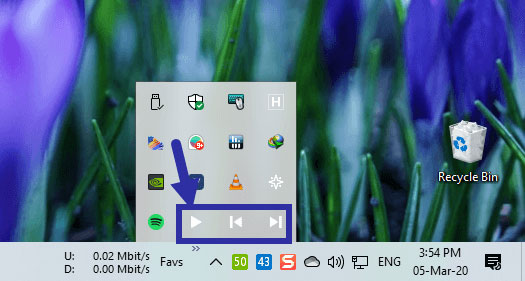How to add media controls to the Taskbar in Windows
If you need quick access to media controls like Play, Pause, Next and Rewind , this is a simple way to add these functions to the taskbar (Taskbar) in Windows.
There is a lot you can do with the Taskbar. For example, you can add bandwidth monitoring, display CPU and GPU temperature, add quick launch toolbar, etc. Simply put, Taskbar is a very flexible place with lots of functions. . So why not add media controls like the Play and Pause buttons to the Taskbar?
Any media player has its own dedicated control options to control the content being played. In fact, Windows provides you with the media control functions right in the thumbnail on the taskbar. If the media player supports generic controls, you can even control it through the media keys on the keyboard. Generally, these options are sufficient for most people. However, if you don't like using keyboard shortcuts or opening background apps just to play or pause songs, you can add media controls directly to the Taskbar.
Add media controls to the Taskbar
While Windows doesn't have built-in options for adding control functions like Play, Pause, Next and Rewind to the Taskbar, you can do that with a simple, lightweight, and free app called is Taskplay. As the name suggests, the application acts as a media driver and allows you to perform basic actions. So follow the steps below to add Play and Pause buttons to the taskbar.
1. First, visit the official Github page and download Taskplay. After downloading, execute the exe file and follow the wizard to install the application.
2. After installing the application, launch it from the "Recently added" section of the Start menu or by searching for "Taskplay".
3. As soon as you launch the application, it will add 3 control functions to the taskbar. They are the Rewind, Play / Pause, and Next buttons. By default, Windows may attempt to hide these new control functions. So if you can't see these controls, click the small up arrow icon on the taskbar.

4. Since we want easy access to the media controls, drag those icons onto the taskbar. When you do that, Windows will remember these locations and display them accordingly.

From now on, whenever you want to play / pause or go to the next / previous song, click the corresponding icon. For example, if you want to play or pause a song or video, simply click on the "Play / Pause" icon (►).
Start Taskplay with Windows
To make things easier, you can launch the Taskplay application with Windows. This ensures that you do not have to manually launch the application and have the media controls from the beginning.
To do that, right-click on the Taskplay icon on the taskbar and select the "Settings" option.

In the Settings window, select the "Start Taskplay with Windows" checkbox and click the Apply button > OK to save the changes.

From now on, Taskplay will start up with Windows.
You should read it
- How to Add Start Tiles to the Taskbar in Windows 8
- 5 extremely effective ways to fix the frozen Taskbar error on Windows 10
- How to fix Windows 11 Taskbar not working
- How to add wallpaper to taskbar on Windows 10
- After all, Microsoft seems to be working on moving the taskbar feature on Windows 11
- This application can bring drag and drop back to the Windows 11 taskbar
 What is Processor Affinity? How to set Affinity Processor on Windows 10
What is Processor Affinity? How to set Affinity Processor on Windows 10 How to install PowerShell 7.0 in Windows 10/8/7
How to install PowerShell 7.0 in Windows 10/8/7 How to completely disable PowerShell 2.0 in Windows 10
How to completely disable PowerShell 2.0 in Windows 10 How to manage disk space for Windows Backup in Windows 10
How to manage disk space for Windows Backup in Windows 10 How to Back Up a Windows Computer
How to Back Up a Windows Computer How to Disable Suggested Apps from Start Menu in Windows 10
How to Disable Suggested Apps from Start Menu in Windows 10